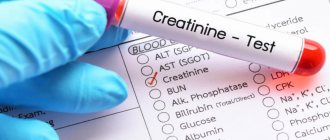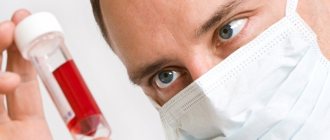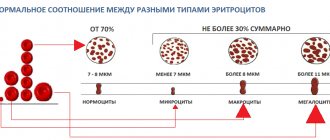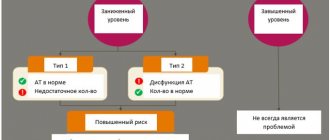Complexes with this research
Examination during pregnancy.
3 trimester 5,730 ₽ Composition For those at risk of COVID-19 Diagnosis of diseases complicating the course of coronavirus infection 2,590 ₽ Composition
Healthy interest Preventive examination to assess the general condition of the body RUB 2,440 Composition
IN OTHER COMPLEXES
- Check-up No. 1 for children and teenagers 6,560 RUR
- Biochemistry of blood. 8 indicators 990 ₽
- Pregnancy planning. Clinical indicators RUB 3,880
- Women's check-up No. 1 RUB 12,520
- Examination during pregnancy. 1st trimester 10,390 RUR
1.Creatinine, normal kidney function and glomerular filtration rate
Creatinine is a waste product created during the breakdown of muscle tissue. Creatinine is filtered by the kidneys and eliminated in the urine. Doctors measure creatinine in the blood to evaluate kidney function. The ability of the kidneys to retain creatinine is called creatinine clearance. Creatinine clearance helps determine the glomerular filtration rate—the rate at which blood passes through the kidneys.
Normal kidney function and glomerular filtration rate (GFR)
All blood passes through the kidneys several hundred times in one day. The kidneys push fluid through tiny filters (called nephrons). Some of the fluid and waste remains in the kidneys and makes up urine.
The rate at which blood passes through the kidneys is called the glomerular filtration rate. Glomerular filtration rate cannot be measured directly, so creatinine and creatinine clearance are used.
Detailed description of the study
The kidneys constantly filter the blood and remove substances formed during metabolism from the body. One of these substances is creatinine.
Creatinine is a metabolite that is formed by the breakdown of the amino acid creatine. It is produced in muscles during their work. By its structure, creatinine is a small molecule, which allows it to be almost completely excreted by the kidneys. Due to constant filtration and excretion, plasma creatinine levels remain relatively constant.
If kidney function is impaired, filtration worsens and the level of creatinine in the blood increases and in the urine decreases. A change in the level of creatinine in the blood plasma may indicate the presence of kidney pathology. These include: acute and chronic glomerulonephritis, pyelonephritis, kidney damage due to diabetes mellitus, arterial hypertension, urolithiasis, amyloidosis.
Changes in creatinine levels may also indicate problems with other organs. Muscle damage, including from trauma or extensive burns, causes an increase in the concentration of creatinine in the blood. A similar situation is observed against the background of starvation and infectious diseases. In this case, the body can use muscle protein as an energy source. With hyperfunction of the thyroid gland, the level of this indicator in the blood also increases.
However, the creatinine level has clinical significance due to the possibility of assessing renal function based on this indicator. Impaired filtration capacity of the kidneys can be asymptomatic for a long time. Therefore, laboratory tests aimed at determining the content of creatinine and urea in the blood are the most important markers of the presence of renal pathology.
The progression of kidney disease is manifested by the following symptoms:
- The appearance of general weakness;
- Problems with urination;
- Decreased appetite and weight;
- Lower back pain;
- Increased blood pressure.
The body's production of creatinine depends primarily on the absolute amount of muscle mass, which is why the normal level of creatinine in children is lower than in adults, and in women it is lower than in men. Also, its level may increase slightly after heavy physical exertion.
Thus, analysis of creatinine levels allows one to suspect renal dysfunction. For a more detailed assessment of the pathology, additional research is necessary on its concentration in daily urine, as well as the content of albumin and urea in the body.
Why do they take a creatinine test before a CT scan?
Examination is recommended for patients before CT with contrast. Contrast involves that before scanning, a special iodine-containing drug is injected into the patient's brachial vein using an injector. It is distributed throughout the circulatory system, “staining” soft tissues and vessel walls on scans (CT angiography), thus increasing the information content of the study.
Contrast is not always performed, but only in cases where it is necessary to examine blood vessels or check organs and soft tissues for damage and tumors, especially oncological ones. The effectiveness of CT with contrast in this case is based on the fact that in places where malignant tumors are localized, the blood supply differs from normal: it is more or, conversely, less intense. Malignant neoplasms appear to be the site of abnormal (pathological) accumulation of the contrast agent, and are more clearly visualized on CT scans.
After the examination, the iodine-containing drug is excreted from the body through urine naturally. Our center uses Omnipaque contrast from the group of the safest non-ionic drugs.
The contrast is excreted from the body by the kidneys within 1-2 days. A laboratory biochemical blood test for creatinine (“Rehberg test” or “serum creatinine”) is necessary in order to exclude kidney pathologies, or more precisely, impaired excretory function.
References
- Clinical protocol for diagnosis and treatment of acute renal failure, 2014. - 24 p.
- Kucher, A.G., Kayukov, I.G., Yesayan, A.M. and others. The influence of the quantity and quality of protein in the diet on kidney activity. Nephrology, 2004. - Vol. 8(2). — P. 14‐34.
- KDIGO practice guidelines for the diagnosis, prevention and treatment of mineral and bone disorders in chronic kidney disease (CKD-MBD). Summary of recommendations. Nephrology, 2011. - T. 15(1). — P. 88‐95
- Nephrology. National leadership / ed. ON THE. Mukhina. - M.: GEOTAR-Media, 2009. - 720 p.
When is it necessary to take a creatinine test before a CT scan with contrast?
Analysis is not required if:
- The patient's age is less than 60 years;
- There is no history of kidney disease or organ surgery;
- There is no history of diabetes mellitus;
- There is no history of gout;
- There is no history of arterial hypertension.
In other cases, there is a high risk of contrast intolerance, up to anaphylactic shock.
You can clarify the advisability of a blood test for creatinine before a CT scan with contrast during a consultation with your doctor or by calling our center’s helpline.
How to lower creatinine
Creatinine can be effectively reduced only by eliminating the cause of its increase and correcting lifestyle. To do this you need:
- It is imperative to conduct a thorough diagnosis to determine the condition of internal organs and muscle tissue;
- For long-term and persistent hypercreatininemia, hospitalization in medical institutions of a certain profile is indicated, where treatment will be prescribed depending on the disease and cause;
- Selection of proper nutrition. Protein foods of animal origin and fats, salt, marinades, smoked foods, seasonings, whole milk and alcohol are almost completely excluded. The diet is enriched with vegetable oils, vegetables and fruits;
- Correction of the amount of fluid consumed. If creatinine is high due to renal pathology, water intake is minimized. In all other cases, high-quality water consumed in the right quantity will help reduce this indicator;
- Correct motor mode. Adjusted depending on the general condition of the person;
- Traditional medicine: various mixtures of medicinal herbs and plants, rice water;
- Taking medications that affect protein metabolism (lespefan, ketosteril, lespinefril);
- Methods of extracorporeal detoxification and hemodialysis (artificial kidney). An extreme measure required if creatinine is elevated to critical levels.
Creatinine is a reliable indicator of the functional abilities of internal organs. Its assessment and correction should be carried out exclusively by specialists.
4.What to do if creatinine clearance is low?
If you have a low creatinine clearance or glomerular filtration rate, your doctor will give you the necessary recommendations.
The main causes of chronic kidney disease are high blood pressure and diabetes. If this is the reason for the low glomerular filtration rate, then you need to start eating right, playing sports and taking prescribed medications. If there are other reasons, then additional tests will be required to clarify them.
As we age, the functioning of our kidneys declines, so it is necessary to check their health regularly.
Norm
The final blood content is expressed as a constant value. If a decrease in value is observed, this indicates some pathologies associated with hormonal imbalances, changes in weight or diet.
As a rule, creatinine levels in women are always underestimated compared to those in men. This is due to different muscle mass.
Normal values for women are presented in the table below.
Normal value, µmol/l
The male half of the population has the following values:
Normal value, µmol/l
Symptoms of decreased levels
Clinical symptoms characteristic of low creatinine levels will depend on the condition of the human body. The pathological process may be accompanied by:
- intestinal dysfunction, manifested by indigestion or stomach upsets;
- pain and heaviness in the right hypochondrium;
- decreased physical activity;
- and lack of strength without reason;
- pain in the heart muscle.
It is necessary to check the concentration of this enzyme after injuries, nervous exhaustion and in the postpartum period.
Role and functions
Creatinine is the main indicator of kidney activity. Determining its concentration as a component of blood fluid is necessary to assess the rate of protein metabolism in the human body. In addition, this value shows how quickly creatinine is excreted by the kidneys.
When proteins and amino acids are broken down, the body releases byproducts, not the least of which is creatinine. Creatine is found in muscle mass and helps provide it with the energy it needs to function properly.
In most cases, this substance is eliminated during:
- digestion of food in the duodenum and stomach;
- physical effort.
When the protein is broken down, the enzyme travels from the bloodstream to the kidneys, where it is filtered and excreted in the urine.
The amount of creatinine in blood fluid indicates the rate of protein breakdown. A reduced concentration of this substance may indicate the development of many pathological processes in the early stages of formation. This breakdown product negatively affects muscle function.
How to increase creatinine levels?
Exercising to increase muscle mass and increasing creatine intake in the diet can help people, especially those on a vegetarian diet.
For people who perform high-intensity exercise, creatine as a dietary supplement is considered safe.
Low creatinine levels may indicate underlying health problems such as liver disease. Most often, low creatinine levels are a normal part of aging or a temporary problem that can be resolved by changes in diet.
How to reduce creatinine in the blood
Creatinine levels can be reduced with medication and folk remedies.
When the first signs of high levels of the substance appear, you should consult a doctor. He prescribes an examination that will show possible pathologies in the body. Only after this do they begin treatment, which should be aimed at eliminating the causes of this condition. In severe cases, the patient is recommended to be hospitalized.
The first step of therapy is detoxification and normalization of metabolism. It is also necessary to adjust the patient's fluid balance. Treatment should be accompanied by monitoring of the condition of the kidneys.
Drug treatment
Of the medications that lower creatinine concentrations, the patient may be prescribed:
- ketosteril;
- chitosan;
- lespephlan.
These medications are taken only as prescribed by a doctor. It is necessary to strictly adhere to the dosage, which is selected individually for each patient.
If the disease is at the second stage of development, drugs to reduce creatinine of plant origin are also prescribed. The last stage requires hospitalization.
In cases of severe renal failure, accompanied by severe organ damage, the patient is prescribed hemodialysis. If he is diagnosed with diabetes mellitus or has a tendency to high blood pressure, hemodialysis is carried out at the second stage, without waiting for severe kidney damage. It is enough that creatinine exceeds 0.71 mmol/l.
After hemodialysis, the patient each time undergoes a urine test, in which the amount of creatinine and urea is calculated. A blood test is also carried out to determine the content of sodium, calcium, and phosphorus.
Treatment with folk remedies
You can lower creatinine in the blood with folk remedies, namely herbal teas and tinctures aimed at improving kidney function. Their use should be supervised by a doctor. Otherwise, a reduced level of the substance in the blood can also harm the patient’s health.
One of the most popular remedies is chamomile. The plant has anti-inflammatory properties. A decoction is prepared from it according to the following recipe: 2 tsp. raw materials are poured with a glass of cold water, after which they are placed in a water bath, where they are brought to a boil. The resulting product should stand for 40 minutes, after which it is filtered. Drink the decoction daily in the morning and evening. You can mix chamomile with mint.
You can also make tea from nettle leaves. It is sometimes combined with calendula flowers and knotweed. You need to pour 2 tbsp. vegetable raw materials with a glass of boiling water.
How to reduce the amount of creatinine in the blood:
- Sage. Tea brewed from sage, dandelion, burdock and birch bark is good for the kidneys. These ingredients improve kidney function and promote the removal of creatinine. After mixing all the ingredients, 3 tbsp. l. raw materials are poured with a glass of boiling water and kept for 30 minutes in a water bath.
- Dandelion. The plant is mixed with violet, St. John's wort, and celandine. The ingredients are poured into 0.5 liters of water and then put on fire. After boiling, the product is kept for 1 hour. Drink the infusion three times a day, 30 minutes before meals. The course of therapy with this remedy lasts 1 month.
- Lingonberry leaves. You need to pour 60 g of raw material into 1 tbsp. hot water, placing it in a water bath for half an hour. Drink the drink three times a day, 1/3 cup. You can also add string, violet, and dandelions.
- Rose hip. Leaves and berries have healing properties. To prepare the infusion, they are mixed with parsley root, dill seeds, and hawthorn leaves. All ingredients are taken in equal proportions and brewed with a glass of boiling water. You can drink the mixture after 3 hours, 5 tbsp. spoons The recommended number of techniques is 7 times.
- Tea is also prepared by mixing rose hips with pomegranate peel. The ingredients in equal quantities are poured into 500 ml of boiling water. You need to drink this remedy throughout the day.
Traditional medicine can cause a number of side effects. Before taking them, you need to make sure there are no contraindications. For example, sage is contraindicated for hypertensive patients, pregnant women, nursing mothers, and cancer patients.
Changing food
To reduce the level you need to adhere to a diet. Patients are contraindicated to consume foods enriched with potassium. It is necessary to limit the amount of salt, sugar and protein. It is replaced with vegetable protein. Animal proteins are not recommended for frequent consumption. Eggs, chicken and fish are eaten no more than three times a week. The recommended daily salt intake is 2 g.
Prohibited foods include yeast baked goods, fatty meat and fish, and milk. Fried, smoked and spicy foods are excluded. It is not recommended to add spices to dishes. Coffee and strong tea should also be excluded.
Patients are allowed to eat fruits, vegetables, nuts, cereals, cheeses, dried fruits, juices, fruit drinks, honey, and vegetable oil. All dishes must be stewed, boiled or steamed.
Patients are recommended to have boiled rice for breakfast every day. It is prepared according to this recipe: 6 tbsp. spoons of rice in the evening, pour cool water so that it covers the rice by 2 fingers. It must stand all night, and in the morning they cook porridge from it, without adding oil or salt. Thanks to this breakfast, creatinine levels decrease within 20-30 days.
Nutrition stabilizes creatinine levels, but if the pathology is advanced, diet is not enough. Patients are advised to drink plenty of fluids, drinking 2 liters daily. If there is not enough water in the body, urine production decreases, resulting in creatinine remaining in the body. Gradually its concentration increases.
Lifestyle change
Sport also affects creatinine levels. The body must not be overloaded. It is recommended to replace intense loads with moderate ones: Nordic walking, yoga. Training should take place daily.
To normalize creatinine levels, you need to pay enough attention to sleep. This should take an average of 6-9 hours.
High creatinine in chronic renal failure affects the functioning of all organs. Pathology is easier to treat in the initial stages, when dietary nutrition and lifestyle changes will help to cope with the problem. In more advanced cases, medication is required. Sometimes they are recommended to be used together with traditional medicine. The only requirement is to adhere to the doctor’s recommendations regarding dosage and make sure there are no contraindications.









